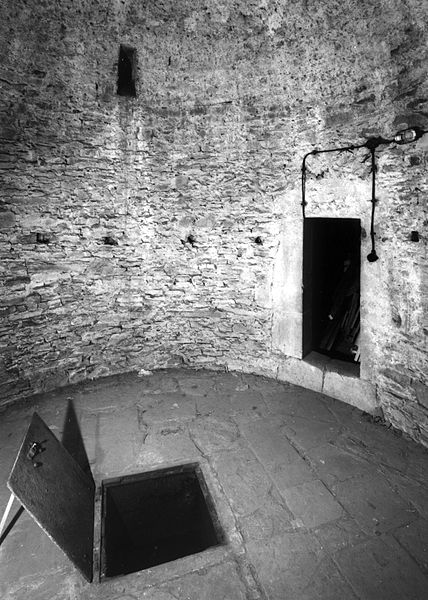An oubliette was a very small and isolated room or dungeon, also called a bottle dungeon, accessible from a small hole or hatch.
Victims were lowered into the oubliette, looking up they would see the hatch as it closed some distance away, much too far away to attempt any escape.

The oubliette was commonly found in the castles during the medieval period. It was commonly used to hold political prisoners, it was dark, damp, isolated, and scary. This kind of dungeon continued to exist even after the end of medieval times.
“Oubliette” is a French term derived from the verb “Oublier” which literally translates to “to forget”. This term was used because the victim once thrown into the Oubliette was considered forgotten by the outside world and remained within the dark confines of the dungeon.
A single trap door at the top of the dungeon was the only entrance to Oubliette which was only accessible via a rope or a ladder.
The idea of Oubliette is thought to have originated from the French castles of the middle medieval times. However, this kind of dungeon was also used in other countries, including England, during the middle and late medieval times. For instance, an Oubliette thought to be from middle medieval times has been found in a castle in Nottinghamshire, England.
The Oubliette was a common feature of many castles during medieval times. While the idea of Oubliette originated from France, it soon became prevalent throughout various countries of Europe during the late medieval times.
The most common feature of an Oubliette, which distinguished it from other kinds of medieval dungeons, was that it did not have any exit door. Instead, it was accessible only from a hatch in a high ceiling. It could be constructed with the rest of the castle or separately.
A very deep, complexed and now famous Oubliette was built at Château de Pierrefonds in France.
Various famous castles throughout medieval times had an Oubliette. Castles like Pembroke and Conwy castle in Wales had special dungeon towers in which certain portions were reserved for Oubliettes.
In France, Oubliette at Pierrefords and Bastille were famous. Oubliettes with dark and lengthy passageways have been found in other places, such as the Black Tower at Rumeli Hisari in modern-day Turkey.
The main purpose of the Oubliette was to confine the prisoners in a dark and narrow space and leave them in solitude for psychological torture. Sometimes, an additional form of torture was also used on political prisoners to extract information.
While the main form of torture in an Oubliette was loneliness and limited space of movement, sometimes additional forms could also be used. Perhaps the most famous Oubliette with the reputation for torture and death existed in the Leap Castle in Ireland. It consisted of an Oubliette that had spikes coming up from the floor.

Sometimes, water was let into the narrow ditch which made survival even more difficult.
The Oubliette was a room a kind of tiny medieval dungeon which was usually underground and was designed to isolate the prisoner completely from the outside world. It was usually a narrow vertical tunnel-like dungeon that had an opening only in a very high ceiling from the prisoners’ point of view. Sometimes, additional forms of torture were also used to increase the suffering of the prisoner.
Oubliettes have been discovered in many castles throughout Europe!
We hope you enjoyed this article on Oubliette Castle dungeons. If you’d like to learn more about other gruesome medieval torture devices like the Oubliette dungeon please look at the links at the bottom of this page.